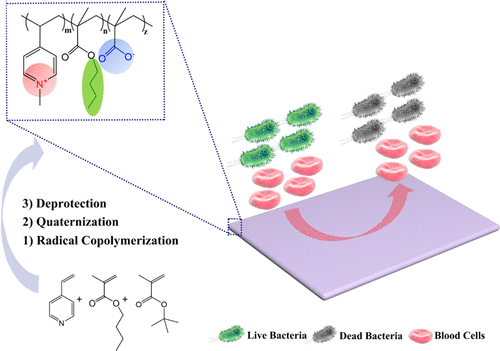当前位置:
X-MOL 学术
›
ACS Appl. Mater. Interfaces
›
论文详情
Our official English website, www.x-mol.net, welcomes your
feedback! (Note: you will need to create a separate account there.)
Bactericidal and Hemocompatible Coating via the Mixed-Charged Copolymer
ACS Applied Materials & Interfaces ( IF 8.3 ) Pub Date : 2018-03-06 00:00:00 , DOI: 10.1021/acsami.7b18889 Xiao-li Fan 1 , Mi Hu 1 , Zhi-hui Qin 1 , Jing Wang 1 , Xia-chao Chen 1 , Wen-xi Lei 1 , Wan-ying Ye 1 , Qiao Jin 1 , Ke-feng Ren 1 , Jian Ji 1
ACS Applied Materials & Interfaces ( IF 8.3 ) Pub Date : 2018-03-06 00:00:00 , DOI: 10.1021/acsami.7b18889 Xiao-li Fan 1 , Mi Hu 1 , Zhi-hui Qin 1 , Jing Wang 1 , Xia-chao Chen 1 , Wen-xi Lei 1 , Wan-ying Ye 1 , Qiao Jin 1 , Ke-feng Ren 1 , Jian Ji 1
Affiliation

|
Cationic antibacterial coating based on quaternary ammonium compounds, with an efficient and broad spectrum bactericidal property, has been widely used in various fields. However, the high density of positive charges tends to induce weak hemocompatibility, which hinders the application of the cationic antibacterial coating in blood-contacting devices and implants. It has been reported that a negatively charged surface can reduce blood coagulation, showing improved hemocompatibility. Here, we describe a strategy to combine the cationic and anionic groups by using mixed-charged copolymers. The copolymers of poly (quaternized vinyl pyridine-co-n-butyl methacrylate-co-methacrylate acid) [P(QVP-co-nBMA-co-MAA)] were synthesized through free radical copolymerization. The cationic group of QVP, the anionic group of MAA, and the hydrophobic group of nBMA were designed to provide bactericidal capability, hemocompatibility, and coating stability, respectively. Our findings show that the hydrophilicity of the copolymer coating increased, and its zeta potential decreased from positive charge to negative charge with the increase of the anionic/cationic ratio. Meanwhile, the bactericidal property of the copolymer coating was kept around a similar level compared with the pure quaternary ammonium copolymer coating. Furthermore, the coagulation time, platelet adhesion, and hemolysis tests revealed that the hemocompatibility of the copolymer coating improved with the addition of the anionic group. The mixed-charged copolymer combined both bactericidal property and hemocompatibility and has a promising potential in blood-contacting antibacterial devices and implants.
中文翻译:

通过混合带电共聚物的杀菌和血液相容性涂层
基于季铵化合物的阳离子抗菌涂料具有高效且广谱的杀菌性能,已广泛应用于各个领域。然而,高密度的正电荷倾向于引起较弱的血液相容性,这阻碍了阳离子抗菌涂层在血液接触装置和植入物中的应用。据报道,带负电荷的表面可以减少血液凝结,显示出更好的血液相容性。在这里,我们描述了一种使用混合电荷共聚物将阳离子和阴离子基团结合起来的策略。聚的共聚物(季铵化乙烯基吡啶共- ñ -丁基丙烯酸甲酯-共-甲基丙烯酸酯酸)[P(QVP-共- ñ BMA-co -MAA)]是通过自由基共聚合成的。QVP的阳离子基团,MAA的阴离子基团和n的疏水基团BMA被设计为分别提供杀菌能力,血液相容性和涂层稳定性。我们的发现表明,随着阴离子/阳离子比率的增加,共聚物涂层的亲水性增加,并且其ζ电位从正电荷降低至负电荷。同时,与纯季铵共聚物涂层相比,共聚物涂层的杀菌性能保持在相似的水平。此外,凝结时间,血小板粘附和溶血试验表明,共聚物涂层的血液相容性随阴离子基团的添加而改善。这种混合荷电的共聚物兼具杀菌性能和血液相容性,在与血液接触的抗菌装置和植入物方面具有广阔的发展潜力。
更新日期:2018-03-06
中文翻译:

通过混合带电共聚物的杀菌和血液相容性涂层
基于季铵化合物的阳离子抗菌涂料具有高效且广谱的杀菌性能,已广泛应用于各个领域。然而,高密度的正电荷倾向于引起较弱的血液相容性,这阻碍了阳离子抗菌涂层在血液接触装置和植入物中的应用。据报道,带负电荷的表面可以减少血液凝结,显示出更好的血液相容性。在这里,我们描述了一种使用混合电荷共聚物将阳离子和阴离子基团结合起来的策略。聚的共聚物(季铵化乙烯基吡啶共- ñ -丁基丙烯酸甲酯-共-甲基丙烯酸酯酸)[P(QVP-共- ñ BMA-co -MAA)]是通过自由基共聚合成的。QVP的阳离子基团,MAA的阴离子基团和n的疏水基团BMA被设计为分别提供杀菌能力,血液相容性和涂层稳定性。我们的发现表明,随着阴离子/阳离子比率的增加,共聚物涂层的亲水性增加,并且其ζ电位从正电荷降低至负电荷。同时,与纯季铵共聚物涂层相比,共聚物涂层的杀菌性能保持在相似的水平。此外,凝结时间,血小板粘附和溶血试验表明,共聚物涂层的血液相容性随阴离子基团的添加而改善。这种混合荷电的共聚物兼具杀菌性能和血液相容性,在与血液接触的抗菌装置和植入物方面具有广阔的发展潜力。











































 京公网安备 11010802027423号
京公网安备 11010802027423号